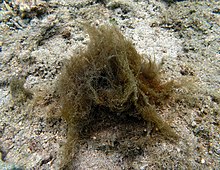| Lyngbya majuscula | |
|---|---|

| |
| Lyngbya majuscula at Réunion | |
| Scientific classification | |
| Domain: | Bacteria |
| Phylum: | Cyanobacteria |
| Class: | Cyanophyceae |
| Order: | Oscillatoriales |
| Family: | Oscillatoriaceae |
| Genus: | Lyngbya |
| Species: | L. majuscula
|
| Binomial name | |
| Lyngbya majuscula | |
Lyngbya majuscula is a species of filamentous cyanobacteria in the genus Lyngbya. It is named after the Dane Hans Christian Lyngbye.
As a result of recent genetic analyses, several new genera were erected from the genus Lyngbya: e.g., Moorea,[1] Limnoraphis,[2] Okeania,[3] Microseira,[4] and Dapis.[5] Several specimens identified as L. majuscula and collected in marine tropical regions are now classified as members of the genera Okeania and Moorea.
L. majuscula is the cause of seaweed dermatitis.[6]
- ^ Engene, N.; Rottacker, E. C.; Kastovsky, J.; Byrum, T.; Choi, H.; Ellisman, M. H.; Komarek, J.; Gerwick, W. H. (2011). "Moorea producens gen. nov., sp. nov. and Moorea bouillonii comb. nov., tropical marine cyanobacteria rich in bioactive secondary metabolites". Int. J. Syst. Evol. Microbiol. 62 (Pt 5): 1171–1178. doi:10.1099/ijs.0.033761-0. PMC 3542135. PMID 21724952.
- ^ Komarek, Jiri; Zapomelova, Eliska; Smarda, Jan; Kopecky, Jiri; Rejmankova, Eliska; Woodhouse, Jason; Neilan, Brett A.; Komarkova, Jaroslava (2013). "Polyphasic evaluation of Limnoraphis robusta, a water-bloom forming cyanobacterium from Lake Atitlan, Guatemala, with a description of Limnoraphis gen. nov". Fottea. 13 (1): 39–52. doi:10.5507/fot.2013.004.
- ^ Engene, Niclas; Paul, Valerie J.; Byrum, Tara; Gerwick, William H.; Thor, Andrea; Ellisman, Mark H.; De Clerck, O. (2013). "Five chemically rich species of tropical marine cyanobacteria of the genus Okeania gen. nov. (Oscillatoriales, Cyanoprokaryota)". J. Phycol. 49 (6): 1095–1106. doi:10.1111/jpy.12115. PMID 27007630. S2CID 35379310.
- ^ McGregor, Glenn B.; Sendall, Barbara C.; Lindell, D. (2015). "Phylogeny and toxicology ofLyngbya wollei(Cyanobacteria, Oscillatoriales) from north-eastern Australia, with a description ofMicroseiragen. nov". J. Phycol. 51 (1): 109–119. doi:10.1111/jpy.12256. PMID 26986262. S2CID 206147172.
- ^ Engene, Niclas; Tronholm, Ana; Paul, Valerie J.; De Clerck, O. (2018). "Uncovering cryptic diversity of Lyngbya: the new tropical marine cyanobacterial genus Dapis (Oscillatoriales)". J. Phycol. 54 (4): 435–446. doi:10.1111/jpy.12752. PMID 29791035.
- ^ James, William D.; Berger, Timothy G.; et al. (2006). Andrews' Diseases of the Skin: clinical Dermatology. Saunders Elsevier. ISBN 978-0-7216-2921-6.